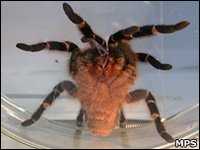Welcome to the inaugural Carnival of the Animals.
The great geneticist JBS Haldane put it best: "The universe is not only queerer than we suppose, it is queerer than we CAN suppose." Weird, wonderful - and often downright unbelievable - new insights into the animal world pop up to surprise us seemingly every day. This week, for instance, we learned why woodpeckers don't get headaches and - perhaps - why elephants are getting increasingly angry with us humans. The aim of this carnival is to bring as many of these discoveries as possible to as wide an audience as possible. We want to do this every Friday, providing you with an entertaining and, hopefully, informative walk on the wild side at the end of each week.
Since announcing this first carnival a week ago, a few of you have been kind enough to post items. Thanks for all your contributions, they are all listed here. We've also added a few other things we've seen and liked this week. If you enjoy what you see here, spread the word, add us and our other cited bloggers to your list of links and send your own posts in to us via the Blogcarnival form which you can find
here. OK, on with the carnival, and first, the items submitted this week:
One of the most blogged about stories on the web this past week has been a major New York Times piece on the mental meltdown supposedly being experienced by elephants. I blogged about it myself. Not everyone is impressed by the NYT's reasoning, however. Josh Rosenau, who writes Thoughts From Kansas, has an alternative viewpoint which he expresses
here Rosenau wonders whether, rather than falling to pieces mentally, elephants are actually staging their equivalent of an insurgency. Rather than being victims of a form of mindless, mass hysteria, he asks, "why not assume that they know exactly what they're doing?"
"Elephants are long-lived, and have very structured societies. Older elephants teach younger ones the ways of the world, and a lot of people point to the loss of older elephants in the ivory trade as a cause of rising elephant violence. Given that elephants are social animals capable of abstract reasoning, communication over long distances, even producing art. They see their territory occupied by outsiders, and some young males respond by attacking the invaders, even at the cost of their lives.," he says.
With Winter around the corner - at least, here in the Northern Hemisphere - a large chunk of the animal kingdom is preparing to hunker down and hibernate.Different species have evolved all sorts of strategies for surviving the coldest months, none more original than the one described in a, er, cool
post by the the guys at Salamander Candy. They reveal how wood frogs effectively turn themselves into lollipops, freezing themselves so that their heart and other organs slow down to a near stop. With the demands on their body reduced to a minimum, the frogs can survive the Winter months on the reserves of frozen glucose in their system.
Much has been written in recent weeks about the arrival of the world's first, specially designed hypoallergenic cats. The news that you can now buy a furry friend that won't trigger your asthma and other allergies has met with a mixed reaction amongst cat lovers. Some can't wait to fork out the $4,000 (just over £2,000) being charged by breeders in the US. Others, like poetic comic
Madeleine Kane , lament the fact that "A kitty whose genes/Are swept allergen clean" demands "such hefty fees". Methinks Ms Kane has put her finger on the key issue here. Who in their right minds is going to pay so much money for a pet, especially one that, the minute you let it out the back door, is going to cover itself in soil, grass and excrement, not to mention - if I may steer you to a popular post of
my own - the blood of the birds, mice and other creatures it is going to kill by night. If that lot don't make you sneeze, nothing will. Significantly, a couple of days after Ms Kane posted her piece, a company selling genetically cloned cats at some $30,000 a throw announced it was going out of business.
Breanne Boyle sent in a nice post on a question every dog owner must have asked themselves at some point: How do you stop your pooch puking in the car? Read her take on this rather sticky subject
here.Finally, three other blogs and stories that caught our eye this week:
One of the big blog-generators this week was, of course, the Ig Nobel prizes, the annual awards for people working on the (lunatic) fringe of science. I like a million others couldn't resist blogging about scientist Ivan Schwab, who was rewarded with an Ig Nobel for discovering why woodpeckers don't get headaches. Visit
here to read the original paper in which Schwab revealed how "evolution has provided the woodpecker with a thick bony skull with relatively spongy bone, especially at the occiput, and cartilage at the base of the mandible to partially cushion the incessant blows". Genius.
Eek, a new species of mouse has been discovered. Mus cypriacus, the Cypriot mouse, is the first new mammal to be unearthed in Europe in many years, although you have to wonder why it's taken us so long to find him. Apparently he predates man by thousands of years. Blogger
John M Lynch at Stranger Fruit introduces this fascinating little fellow.
Ever seen a starfish walk along the beach? Visit
The Science Pundit and be amazed.
